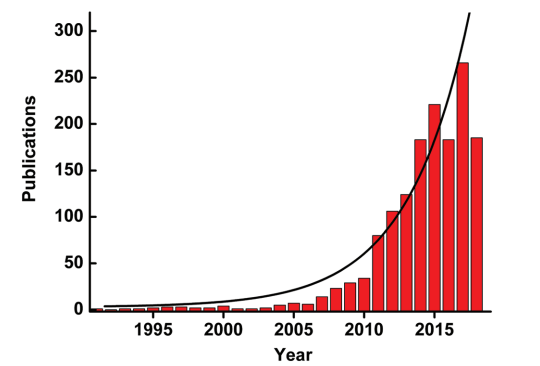Some inherent defects of natural enzymes, such as low stability and high price, greatly limit its practical application in the fields of biomedicine, food safety and environmental protection. Hence, the use of biological or chemical methods to simulate natural enzymes not only has important scientific significance but also has great practical application value. In recent years, with the rapid development of nanoscience, researchers have discovered that some nanomaterials inherently have the ability to mimic the catalytic activity of certain biological enzymes, which are called nanomaterial-based artificial enzymes or nanozymes for short. Since Chinese scientists Xiyun Yan et. al. (2007) first discovered that Fe3O4 nanoparticles have a catalytic activity similar to peroxidases, the research on nanozymes has risen rapidly. In 2013, Prof. Hui Wei and Academicians Erkang Wang further defined the concept of nanozymes as "nanomaterials with enzyme-like properties" in their review of nanozymes published in Chem. Soc. Rev. The discovery of nanozymes has changed people's traditional concept that inorganic nanomaterials are biologically inert, revealing the inherent biological effects and new properties of nanomaterials, enriching the research of artificial enzymes, and greatly expanding the scope of nanomaterials application. Nanozymes have the advantages over natural enzymes or traditional mimic enzymes, including easy preparation, low cost and high stability. In addition, the excellent physical and chemical properties of nanomaterials (such as optical, electrical, magnetic, thermal and mechanical properties, and large specific surface area) endow nanozymes with dual or multiple functions and possibilities of regulating their catalytic activities, modifying their surface and constructing probes.
In the past few years, due to the rapid development of nanotechnology, biotechnology, catalytic science, and computational science, great progress has been made in the field of nanozymes, including broadening the type of enzyme-like catalytic reaction of nanozymes, regulating enzyme-like catalysis activities, revealing the catalytic mechanism and expanding applications (Figure 1). The development of nanozymes has ranged from the initial superoxide dismutase mimic enzyme fullerene derivatives to the peroxidase mimic enzyme iron oxide, and the nano mimic enzyme Prussian blue with various enzymatic activities. The application of nanozymes has expanded from Bioassay and environmental protection, to disease diagnosis and treatment and other fields. So far, more than 200 research groups around the world are actively engaged in nanozyme research, contributing to its development. According to the web of science statistics, nearly 1,500 academic papers have been published in the field of nanozymes, and the number is exponentially surging (Figure 2).

Figure 1 A brief timeline for the development of nanozymes (natural enzymes and artificial enzymes are listed for comparison)

Figure 2 Number of published papers on nanozymes by the end of May 2018. Data are from the web of science.
Recently, Prof. Hui Wei 's group published a review entitled Nanomaterials with enzyme-like characteristics (nanozymes): next-generation artificial enzyme (Ⅱ) in Chem. Soc. Rev. This review covers various types of nanozymes and their applications in biosensing, diagnosis and treatment, and environmental protection. In addition, the current challenges of nanozymes research and future direction are discussed. The review also provides rich supplementary information for readers' further reference (Chem. Soc. Rev., 2019, 48, 1004-1076). This review was selected as the front cover of the fourth issue of Chem. Soc. Rev.

Figure 3 Chem. Soc. Rev. Journal Cover
For more information, please follow the homepage of Prof. Hui Wei’s research group: http://weilab.nju.edu.cn
Links to related articles:
http://dx.doi.org/10.1039/C8CS00457A
https://dx.doi.org/10.1039/C3CS35486E

